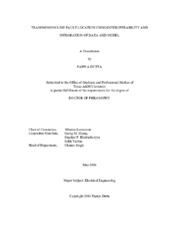| dc.contributor.advisor | Kezunovic, Mladen | |
| dc.creator | Dutta, Papiya | |
| dc.date.accessioned | 2015-01-09T19:57:13Z | |
| dc.date.available | 2016-05-01T05:30:58Z | |
| dc.date.created | 2014-05 | |
| dc.date.issued | 2014-01-10 | |
| dc.date.submitted | May 2014 | |
| dc.identifier.uri | https://hdl.handle.net/1969.1/152466 | |
| dc.description.abstract | This dissertation proposes selective scheme of transmission line fault location by choosing between two different types of fault location algorithms depending on the availability of measurements.
The first type is an accurate method to detect, classify and locate transmission line faults using synchronous samples of voltages and currents captured during fault transients from both ends of the transmission line of interest. The method is tested for several faults simulated on IEEE 118 bus test system and it has been concluded that it can detect and classify a fault using pre and post fault recorded samples within ½ of nominal frequency cycle of fault inception and locate fault with 3% accuracy. This time response performance is highly desirable since with the increasing use of modern circuit breakers which can open the faulty line in less than two cycles, the time window of the fault waveforms is significantly reduced due to the unavailability of measurement signals after breakers open.
The second type is a sparse measurement based fault location scheme using phasor measurements from different substations located in the vicinity where the fault has occurred and can be applied if the measurements are not available from any of the line ends. Fault resistance is one of the major sources of uncertainty in this type of transmission line fault location estimation. A correction scheme to reduce impact of fault resistance on sparse measurement method is proposed.
Both of the proposed schemes require power system model information, and in each case field captured measurements at different substations need to be integrated with SCADA data recorded by remote terminal units to implement a system level transmission line fault location scheme. This requires a data processing solution which will correlate data and power system models expressed in different formats but having similar descriptions seamlessly, extract useful information from them automatically, and use such information in proposed fault location applications efficiently.
A third contribution of this dissertation work is development of a unified representation of data and model, which allows seamless information exchange between different power system models and between data and models, thereby achieving interoperability and integration. This approach allows easy implementation of future fault location schemes with the same data used for the proposed schemes, as well as an easy addition of data from new intelligent electronic devices that may be used for the same algorithms in the future. | en |
| dc.format.mimetype | application/pdf | |
| dc.language.iso | en | |
| dc.subject | Power system fault detection | en |
| dc.subject | classification | en |
| dc.subject | location | en |
| dc.subject | Power system interoperability | en |
| dc.title | Treanmission Line Fault Location using Interoperability and Integration of Data and Model | en |
| dc.type | Thesis | en |
| thesis.degree.department | Electrical and Computer Engineering | en |
| thesis.degree.discipline | Electrical Engineering | en |
| thesis.degree.grantor | Texas A & M University | en |
| thesis.degree.name | Doctor of Philosophy | en |
| thesis.degree.level | Doctoral | en |
| dc.contributor.committeeMember | Bhattacharyya, Shankar P | |
| dc.contributor.committeeMember | Huang, Garng M | |
| dc.contributor.committeeMember | Yurttas, Salih | |
| dc.type.material | text | en |
| dc.date.updated | 2015-01-09T19:57:13Z | |
| local.embargo.terms | 2016-05-01 | |


